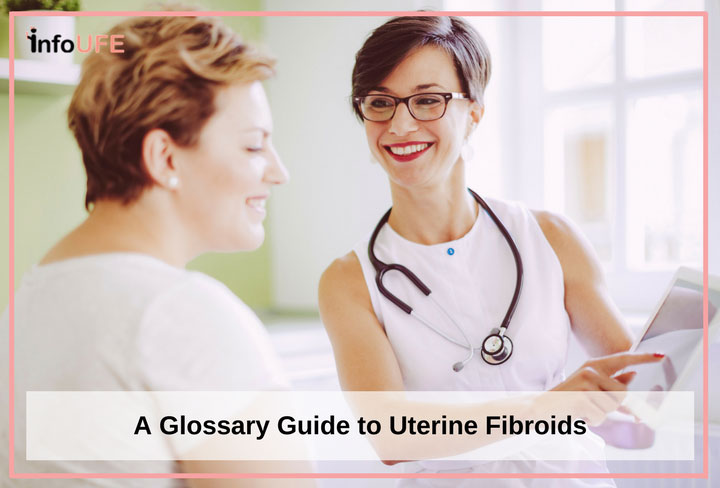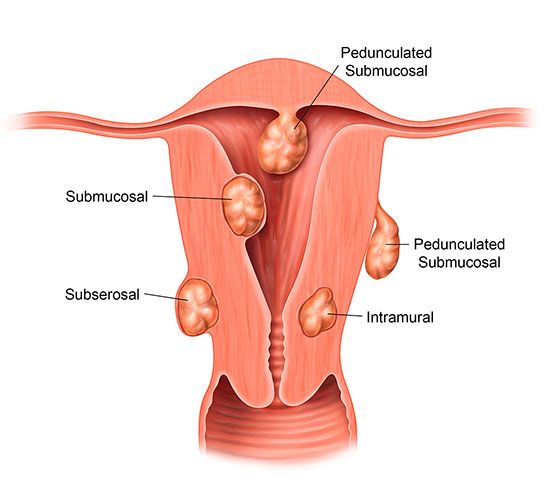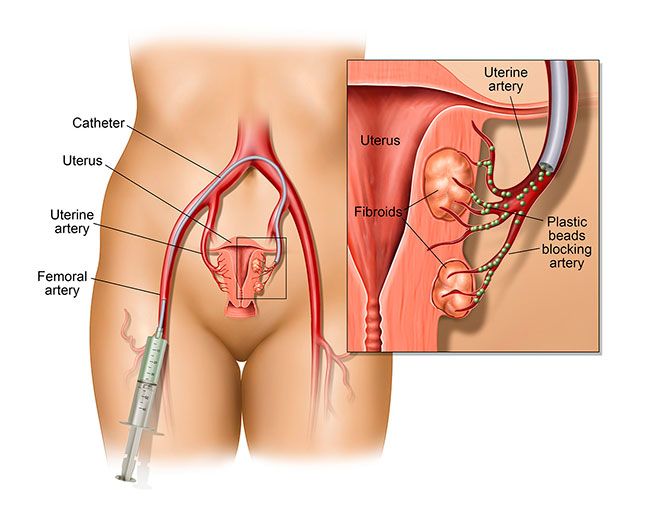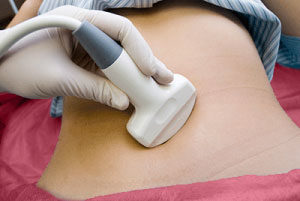
Uterine fibroids are common, non-cancerous tumors of the uterus. It’s estimated that by the age of 35, 40% of Caucasian women and up to 60% of African American women will have uterine fibroids. Genetics, race, obesity, and higher estrogen levels are all considered risk factors for developing fibroids.
If you or a loved one has been diagnosed with uterine fibroids, the most common benign gynecological tumor, you may want to learn more about this condition. This guide will help you become better acquainted with the common medical terms encountered when researching fibroids and treatment options.
Uterine fibroids are the reason for the majority of hysterectomies, or surgical removal of the womb. Many uterine fibroids don’t cause symptoms and are only found during a pelvic exam. However, women who do have symptoms related to their uterine fibroids may experience symptoms such as:

- Heavy bleeding or painful periods
- Feeling of fullness or pressure in the pelvic area
- Swollen lower abdomen
- Frequent urination
- Pain during sex
- Lower back pain
- Constipation i
The following is a glossary guide to help you understand more about the symptoms and treatments options for uterine fibroids.
A
Artery: A vessel that carries oxygenated blood away from the heart to the body’s cells, tissues, and organs.
Asymptomatic: Presenting no symptoms of disease.
Analgesic: A drug that alleviates pain without causing sedation or loss of consciousness.
Anesthesia: A drug that blocks pain impulses from nerves. With general anesthesia you are unconscious, or asleep. With local anesthesia you are conscious, or awake.
B
Benign: Not malignant, noncancerous. A benign tumor does not invade surrounding tissue or spread to other parts of the body.
Biopsy: The removal of a sample of tissue for examination of the presence, cause, or extent of a disease.
C
Catheter: A thin, flexible tube for insertion into vessels for diagnostic or therapeutic purposes.
Cervix: The lower, narrow part of the uterus.
Constipation: Infrequent and difficult bowel movements.
Conscious sedation: A combination of sedative and analgesic medications to help you relax and to block pain. While under conscious sedation the patient is semi-conscious and able to respond to verbal commands and physical stimuli. This may also be referred to as “procedural sedation.”
D
Diagnosis: The act of identifying a disease or illness from its signs and symptoms.

E
Embolization (Uterine Fibroid Embolization): A minimally invasive outpatient procedure that intentionally blocks the flow of blood in small veins or arteries.
Estrogen: A female hormone produced by the ovaries that promotes the development and maintenance of female characteristics of the body.
F
Femoral artery: The second largest artery in the body located in the thigh.
Fertility: The ability to become pregnant and bear children.
Fibroids: Common, benign tumors of muscular and fibrous tissues, that typically form in the walls of the uterus.
H
Hysterectomy: A surgery to remove the uterus.
Hysteroscopy: A procedure to inspect the inside of the uterus using a viewing scope to diagnose and treat causes of abnormal bleeding.
I
Infertility: The inability to become pregnant and bear children. A couple is considered infertile if they are unable to conceive after 12 months or more of regular unprotected sexual intercourse.ii
Interventional radiologist: A radiologist who uses minimally invasive image guided methods (x-ray technology) to diagnose and treat diseases in order to minimize risks to patients and improve patient outcomes.
Intramural fibroids: Fibroid tumors located within the muscular walls of the uterus.
L
Leiomyoma: A benign smooth muscle tumor of the uterus. Also called uterine fibroid or myoma.
Malignant: A tumor that is malignant can spread to and destroy nearby tissues and may recur after removal.
Menorrhagia: Excessive uterine bleeding occurring at menstruation.
Minimally invasive: A medical treatment or procedure requiring as little incision to the body as possible, resulting in minimal damage of body tissue.
MRI: Magnetic resonance imaging. A non-invasive imaging method using magnetic fields and radio waves to create detailed images of the organs and tissues in the body.
Myoma: A benign tumor of muscle tissue.
Myomectomy: The surgical removal of a fibroid from the uterus.
N
Noninvasive: A medical test or procedure that does not require an incision as entry into the body.
Nonsurgical: A medical treatment that does not involve cutting open the body.
O
Outpatient procedure: A medical procedure in which a patient is not hospitalized overnight, but visits a hospital, clinic, or associated facility for diagnosis or treatment.
P
Pelvic exam: An examination of the organs of the female reproductive system.
Pedunculated fibroids: Fibroids growing on or being attached to the uterus by a narrow stalk.
R
Radiologist: A physician specialized in various imaging techniques to diagnose diseases and injuries.
S
Submucosal fibroids: Fibroids that develop underneath the uterine lining within the uterine cavity causing excessive and prolonged menstrual bleeding.
Subserosal fibroids: Fibroids that develop in the outer portion of the uterus and continue to grow outward.
Symptomatic: Showing or experiencing symptoms.
T
Transvaginal ultrasound: A test which uses high frequency sound waves to generate an image of a woman’s reproductive organs including the uterus, ovaries and cervix.
Tumor: An abnormal growth of tissue which can be benign or malignant.

U
Ultrasound: High-frequency sound waves not audible to the human ear used for diagnostic or therapeutic purposes.
Uterine fibroids: Benign tumors of the uterus causing some women to have painful or heavy periods. Also called leiomyomas or myomas.
Uterus: A hollow, pear-shaped organ located in a woman’s lower abdomen where babies are conceived and gestate before birth. Also called the womb.
V
Vagina: The muscular tube that extends from the cervix to the outside of the female body.
W
Womb: A hollow, pear-shaped organ located in a woman’s lower abdomen where babies are conceived and gestate before birth. Also called the uterus.
X
X-ray: An electromechanic wave of high-energy used to create images of the inside of the body for diagnosing, monitoring and treating many medical conditions.
Hopefully now you have a better understanding about uterine fibroids and what were previously complicated or unrecognizable medical terms. It’s important to learn as much as you can before choosing a treatment plan and make the best possible choices about your care.
Hysterectomy was once the traditional treatment for troublesome fibroids, but it helps to know there are treatment options available that are alternatives to surgery. Find an interventional radiologist in your area who can perform uterine fibroid embolization and set up a consultation to learn more.
Sources:
i Zimmermann, A., et al., Prevalence, symptoms and management of uterine fibroids: an international internet-based survery of 21,746 women. BMC Womens Health, 2012. 12(6): p. 1-11.
ii http://www.who.int/reproductivehealth/topics/infertility/definitions/en/. Accessed 8/7/2017.


